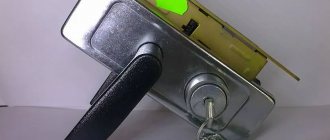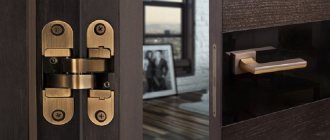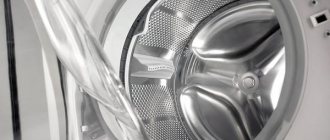Lock production technologies do not stand still, however, getting a key stuck in a keyhole remains one of the most common problems. It’s difficult to insure yourself against such an unpleasant surprise: even the most expensive and high-quality locks, just like budget models, unfortunately, can fail.
If you find yourself in such a situation, then calling a specialist will help you save your nerves and keep the lock intact. But as often happens, a broken lock takes you by surprise and there is no time or opportunity to call a repairman. In this case, it is important to understand the cause of the breakdown and try to remove the key yourself.
Assessing the situation
First of all, you need to stop panicking and assess the situation sensibly:
- if you have absolutely no skills in handling a lock , then in most cases it will be better to wait a little for the technician than to try to do something on your own and only make the situation worse;
- if you know something about the design of locks or even once installed or changed a lock yourself, then you can try to do it on your own;
- if time is short, even the most inexperienced person will try to do something on their own - it’s in our blood, so there’s no point in stopping you - we’ll just direct your efforts in the right direction so as not to make things worse;
- Be prepared for the fact that if the apartment is closed, you will have to turn to neighbors or friends for some tools. If the key gets stuck when the door is open and there is access to the apartment, then all the necessary tools can be found at home. And in general, when the apartment is open, you can act much more boldly and certainly try to solve the problem yourself before turning to the master;
- If you managed to remove the key, then you should not rush to insert it back and try again to open or close the lock.
Tools and accessories
To get the key out of the lock, we may need tools and devices such as:
- syringe with needle;
- screwdriver;
- drill;
- hammer;
- hairpin;
- pliers;
- pliers;
- tweezers;
- jigsaw;
- awl;
- self-tapping screw;
- grinder saw and others.
You won’t need absolutely all the tools at once, but three or four of them will definitely come in handy.
When trying to open a long-suffering door, do not forget that the secret of the lock must be handled very carefully.
How to remove a key stuck in a lock?
First, you should try the easiest way to remove a stuck key from a lock. It is best suited if there is access to the apartment - otherwise, you can contact your neighbors to borrow the necessary materials and tools. In this way, you can try to remove the key from the lever and cylinder locks.
The procedure is as follows:
- spray a liquid into the lock cylinder that removes dirt and rust, lubricates and has excellent penetrating properties - this is the famous WD-40. If it is not available, then you can take kerosene. If you don’t have kerosene, then try using machine oil or, at worst, vegetable oil, solid oil, or silicone. The easiest way to fill is through a syringe or spirtz.
Do not use cotton swabs, cotton pads or other soft, fluffy materials - their particles may get into the mechanism, and then all further instructions are meaningless
- wait 10 minutes for the liquid to do its job;
- With a little force, try turning the key one way or the other. Do not overdo it! Do not use too much force;
- if your hands slip, you can try to use pliers, but then it will be difficult to control the level of effort applied, there is a high risk of breaking the mechanism, and then only a master will help;
- If you managed to get the key, we do not recommend inserting it into the lock again. Ideally, the lock needs to be replaced.
Should you try to fix it yourself?
If the lock is jammed, you should contact a specialist. To solve a problem yourself, you need free time, tools, knowledge and skills. In the absence of understanding of the design of the locking device and experience in carrying out repairs, the situation can only worsen. As a result, time will be lost and more money will have to be spent to solve the problem. If you have no confidence in your own strengths and capabilities, it is better to immediately turn to a professional. But a specialist must be selected responsibly. Otherwise, you can call a specialist and find yourself in a difficult situation when he cannot carry out repairs and eventually says that the entire system needs to be changed. As a result, you will have to pay for diagnostics, repairs and replacements. Financial expenses will be significant. It is worth calling a specialist if the key turns every once in a while, but you need to choose a specialist with a high rating and positive reviews. It will be good if it is not private, but full-time. Service companies provide a guarantee for the work and pre-calculate the estimate. Their staff includes competent and experienced specialists. Our craftsmen repair the locking mechanism quickly and efficiently.
Did you like the article? Tell your friends:
If the key still won't work
If you did everything as written above, but the key remains stuck in the lock, then you will have to use more drastic measures - physical force or unscrew the mechanism.
If the key is stuck in the cylinder lock , try the following:
- it is necessary to hit the lock with a heavy blunt object;
- with a correctly applied blow, the larva will fall apart into two parts, and this is already more than half the success;
- All that remains is to move the lock tongue, and this can be done even with an ordinary screwdriver, and that’s it - the door is open, however, the lock will have to be changed.
Perhaps you were lucky and the key got stuck in the lock when the door is not yet closed:
- There is no need to hit anything or knock out anything, but you will have to tinker with a screwdriver; it is best to take a minus one;
- unscrew all the bolts that hold the lock, remove the locking mechanism, and then the fastening element due to which the key is stuck in the lock;
- The good news is that you don’t have to replace the entire lock, but you will need a new cylinder.
Adviсe
Carry with you the phone number, business card of a special service or technician who can help in the event of such force majeure. This way you will save your nerve cells and can quickly fix the problem. And at worst, when there are no facilities at all, there are no neighbors, and it’s cold outside, the door can be broken down. But only if it is wooden: a metal model can hardly be handled alone, especially if it opens outwards.
We also recommend that you read the information on how to recode the lock on your front door.
Radical measures
If you need to get into the apartment urgently, and there is absolutely no time to wait for the master, and independent attempts did not help or even worsened the situation, then you will have to take extreme measures. There are several options, and all are designed for people with physical strength:
- try to knock down the door . You will need enough force, but it is not a fact that the door leaf will give in. In the case of an old wooden door, everything is simple, but if a modern metal entrance door is installed, then knocking it out will be very difficult, and in some cases almost impossible;
- cut the hinges , but to do this you will have to ask a neighbor/friend/relative for a grinder with a metal disc. Naturally, the hinges must be visible, so this method is not suitable for doors mounted on hidden hinges. The locking bolt can ;
- Another option is to drill out the lock using a drill with a metal drill bit.
In all these cases, you will have to change either the lock or the door, which is why these methods are used when it is necessary to get into the apartment very urgently.
If all else fails, you will have to call a specialist.
Complex cases
If you tried a simple method to get the key, but nothing worked, you can try a more complex option. When the mechanism is jammed and you cannot get the key, you need to knock out the cylinder if we are talking about a cylinder lock. To do this you will need a heavy, blunt object. If you hit the lock correctly, the larva will fall apart into 2 parts, and you will be able to get into the apartment. You can use a regular screwdriver to open the locking tab. Place it in the gap between the door and the frame where the shutter is located. Press the screwdriver firmly several times and the door should open.
In cases where the door has not been closed and you have access to the inside of it, remove the entire lock. To do this, you will need to take a minus screwdriver and unscrew all the bolts holding it to the door. Some of them will be hidden behind visual protection.
If all else fails, pay attention to those moments when the key gets stuck. In cases where the lock only jams when opening and closing, but there are no problems when the door is open, the problem is in the installation of the structure. Most likely, mistakes were made when installing the frame and fixing the door and a misalignment occurred. Because of it, you will not be able to operate the lock normally when the door is closed. The locking tab will cling to the frame under the influence of the weight of the entire door. In this case, either call a technician who can adjust the structure, or try to fix the problem yourself if you know how to do it.
When the method of unwinding and knocking out the larva does not help, you can take extreme measures, which are only relevant in cases where you urgently need to get into the apartment, since the door will be unsuitable for further use:
- Knock her out with force. To do this you need to have powerful physical strength. Old wooden doors are easy to break. However, iron doors, and not all new wooden ones, cannot be opened only by force.
- Cut the hinges holding the door suspended. To open it this way, you will need a large grinder with a whole metal disc. A prerequisite is the visual visibility of the hinges through the gap between the door itself and the frame. You can cut out the lock. This can be done using either a grinder or argon.
- You can also drill a keyhole using a drill and a high-quality metal drill bit.
However, if you are in no hurry to get inside the apartment, do not use such methods. It’s better to call a master who will keep your door intact.
How to remove the key from a padlock?
When a key gets stuck in a padlock, many people immediately turn to radical measures - cutting the lock shackle with a metal hacksaw. If you don’t mind the lock, and you have a hacksaw at hand, then this is a working and 100% option, otherwise you will have to act in almost the same way as with a mortise mechanism, because the key jams for almost the same reasons.
Procedure:
- coat the mechanism with WD-40 or kerosene, wait and try to turn the key, i.e. the technique is the same as described above;
- You can try to heat the lock, but it is logical to test this method only in the cold season, since the big problem with padlocks is sensitivity to low temperatures.
Opened door
When the problem arose before the door was closed and the key turns but does not come out, here you can quickly and painlessly solve it. To do this, you need to remove the “core”. At the end of the door, where the lock itself is installed, there is a cylinder fastening element on the bar (a long screw with a flat head). Unscrew it with a screwdriver, then, turning the key, find the position of the open bolts of the lock - press on the cylinder on the back side of the door, where the handle is. The cylindrical element should fall out easily. Buy it and insert a new core using the same method.
What to do if the key breaks in the lock and gets stuck?
Probably worse than just a stuck key is a key that gets stuck and breaks in half. This can happen as a result of careless handling of the lock, attempts to remove the key, or if a low-quality lock and an equally low-quality key were used.
In any case, the following techniques can help:
- pour WD-40 or kerosene (or oil, or silicone, etc.) into the keyhole, wait 10 minutes and try to pull out the rest of the key. You won’t be able to catch the fragment with your bare hands, so you can use pliers or tweezers;
- you can try to pull out the key with a magnet if high-quality metal was used in its manufacture;
- You can try to insert a jigsaw blade into the keyhole, press it against the key and pull it towards you until you can hook the rest with tweezers or pliers;
- An interesting way is to use a lighter and a glue stick. True, the method works if the key remains in the lock in the neutral position.
Preventive measures
In order to ensure that there is no need to remove a stuck key from the mechanism in use, and the doors open every time without squeaking or any problems, it is necessary to regularly inspect the lock for corrosion and carry out its treatment. One of the main procedures is considered to be high-quality lubrication of the mechanism.
To do this you will need to perform the following manipulations:
- The cleaning liquid is poured into the lock. It is based on kerosene, which will help you easily remove all types of contaminants.
- The key is inserted into the well, and after it is removed, it is wiped dry to remove the removed dirt.
- Similar actions must be repeated several times.
- Pour machine oil over the mechanism and turn the key several times.
- All parts are wiped dry.
If you treat the fittings with the utmost care, you can prevent the slightest damage and avoid unpleasant situations associated with the lock getting stuck in the future.
Why does the key get stuck in the door lock?
Knowing the reasons for a key getting stuck is useful - this can significantly reduce the risk of getting into unpleasant situations.
The key may get stuck in the lock due to the fault of the person using the key:
- the key must not be used for other purposes, i.e. if you regularly open bottles with it, cut the tape on packages, then don’t be surprised that sooner or later you will find yourself with a stuck key;
- if you apply unreasonably great force when opening the lock, you can damage both the locking mechanism itself and the key;
- someone who slams the front door often and hard may one day be punished by the door - the key will get stuck in the lock;
- debris getting into the lock;
- improper installation of the door or gradual distortion of the door leaf;
- operation of the locking mechanism at high humidity without proper care;
- Have you ever lost a key, ordered a duplicate, and the master did not cut it accurately enough?
It may also be that the reason lies in a poor-quality lock or key. It happens that the pins in the lock are made of too soft metal, and as a result they do not move back when the key gets inside, but block it. In this case, even careful handling of the lock will not help, so the best prevention would be to choose a lock from a reliable manufacturer.
We understand the reasons for the key getting stuck
Every person has a situation in their life when the key is stuck in the lock and they cannot close or open the door.
Or the key is difficult to remove from the lock of the door of an apartment or house. Some people get it quickly themselves, without resorting to the services of a specialist or information from the Internet, while others do the opposite. If you belong to the second type of people, then do not rush to call customer service right away, read this article first and use the tips given in it. Why does the key get stuck in the lock? What causes of failure can be identified when such a situation occurs?
- the key wears out due to improper use. For example, bottles are often opened with a key or cans are opened with it. As a result of such machinations, the key may lose its former shape and become crooked;
- wear or aging of the lock;
- micro contamination or ingress of debris and dust into the secret mechanism of the lock;
- opening the lock with a foreign object;
- use of low-quality keys.
How to open a door if the lock is jammed
Available methods for troubleshooting with your own hands:
- To open the door if the lock is jammed, you can try to clear the lock slot of debris and dust.
- Lubricate the device and try to open it again.
- If the mechanism is jammed due to the door being warped, you need to find a wedge and insert it into the gap between the door frame and the leaf itself. This will allow you to return the structure to its original position. Once aligned, the door should open.
- The cross-shaped lock can be easily opened without a key using chewing gum and a screwdriver. Chewing gum is placed in the well. After this, you need to insert and carefully twist the screwdriver. A few turns will allow the gum to mold to the shape of the key and the locking mechanism will open.
https://youtube.com/watch?v=jKNkoSCa9QE
The key is difficult and does not move completely into the keyhole
This means that the lock cylinder or lever mechanism has broken. In such a situation, you will need a special tool and the help of professionals, because you will have to completely dismantle the device.
Problems with the lock may occur due to the key inserted from the inside. If it is not turned, you can try to push the key with a pin or nail through the lock slot.
The locking mechanism, which is subject to intensive use for a long time, must be lubricated. After processing, carefully insert and remove the key. You can lightly tap on it, while gradually pushing the key inward. Do this slowly so as not to completely break the device.
A decorative strip may interfere with the key's movement. After removing it, the key enters the keyhole all the way.
Blockages in the keyhole are detected by highlighting it. This can be done with a flashlight or mobile phone. Broken matches or small debris are removed with a metal hook or tweezers.
The key won't come out
If you cannot remove the key from the keyhole, you should not make sudden movements to avoid breaking it. Try pouring kerosene or special machine oil into the gap using a syringe. After 10 minutes, shake the key, but do not force it. If you managed to open the front door of your apartment, remove the lock and check its core.
Sometimes the mechanism works when the door is open, but when closed it jams. In this case, you need to bore the doors.
The tongue is jammed
It happens that the door does not open, even if you turn the key all the way. This problem can be easily resolved by using any narrow metal object, such as a utility knife, to open the lock. Any plastic card will do.
Pull the door leaf away from the jamb and insert an ax or crowbar into the resulting gap. This will give you access to the tongue. Try pressing it into the lock with a knife, the door should swing open. After this, you need to disassemble the mechanism and find the cause of the breakdown. Most often this is a weakening of the spring.
The lock is broken
In cylinder models, you can remove the broken cylinder using a drill or pliers. The outer part is bitten off or drilled out, and the remains are knocked out with a thick screwdriver and hammer. After this, the crossbars located on the drive mechanism are moved with a metal hook.
The main problem with lever locks is plate jamming. It is not easy to open such a mechanism, therefore, without the necessary skills, it is better to entrust the solution to the problem to specialists.
If a door lock is jammed, it is much easier to open it from the inside because almost every home has the necessary tools. In addition, from the inside you can easily remove the mechanism, especially the overhead type.
Types of locks
By type of key:
- cylinder - with a small key with protrusions and notches;
- level key – a long key with “wings” on the edges;
- Phillips - with a key similar to a Phillips screwdriver;
- disk - the key is small and semicircular with notches.
By type of insert:
- the overhead lock is installed on the door leaf, closed with a key from the outside, and a latch from the inside;
- mortise is built inside the door, the handle controls the tongue;
- A padlock is installed separately from the locking element and is used for garage doors or gates.
The most popular are mortise lever locks.











